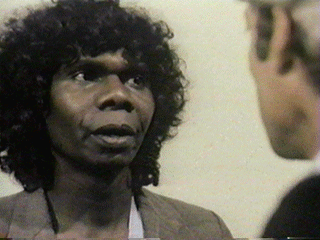Ten Canoes (2006)
A parable of forbidden love from Australia's mythical past, with storytelling by Australian icon David Gulpilil (Walkabout, The Last Wave, Crocodile Dundee and Rabbit-Proof Fence) and starring his son Jamie as the covetous youth Dayindi, Ten Canoes is a ground-breaking glimpse into aboriginal life centuries before European settlement.
Ten Canoes - Trailer - YouTube
Ten Canoes - Wikipedia, the free encyclopedia
Ten Canoes is a 2006 film. It was directed by Rolf de Heer and Peter Djigirr and starred Crusoe Kurddal. The title of the film arose from discussions between de Heer and David Gulpilil about a photograph of ten canoeists poling across the Arafura Swamp, taken by anthropologist Donald Thomson in 1936.
The film is set in Arnhem Land, in a time before western contact, and tells the story of a warrior Dayindi (Jamie Gulpilil), who hunts goose eggs while being told another story about another young man who, like Dayindi, coveted his elder brother's wife. The sequences featuring Dayindi, set shortly before contact with white people, are in black and white, while shots set in the present and in the distant past are in colour. The film is narrated in English by David Gulpilil; all protagonists speak in indigenous dialects of the Yolŋu Matha language group, with subtitles. A narration in Yolŋu Matha is also available. [more]
Gulpilil
His name is David Gulpilil.
photo: Gulpilil with Richard Chamberlain
in Peter Weir's film The Last Wave (more below)
His image might come to mind if someone asked you to name an Australian Aboriginal actor, or you might recognize him as "that kid from Walkabout." You see him here working with Richard Chamberlain in Peter Weir's film The Last Wave. This *official site is a celebration of his work in film, traditional dance, and children's literature as well as his advocacy of social justice for Australian Aboriginal people. - Mischa B. Adams -- Santa Cruz, California, USA
 Book cover for Gulpilil's Stories of the Dreamtime -- text by David Gulpilil, compiled by Hugh Rule and Stuart Goodman, illustrated by Allan Hondow, photography by Stuart Goodman: Collins, Sydney, Auckland.
Book cover for Gulpilil's Stories of the Dreamtime -- text by David Gulpilil, compiled by Hugh Rule and Stuart Goodman, illustrated by Allan Hondow, photography by Stuart Goodman: Collins, Sydney, Auckland.
> Honoring David Gulpilil
see also > David Gulpilil - Wikipedia, the free encyclopedia
The Last Wave (1977)
one of my all-time favorite films, starring Richard Chamberlain and Gulpilil
THE LAST WAVE Movie Trailer 1977
The Last Wave is a 1977 Australian film directed by Peter Weir. It is about a white Australian lawyer whose seemingly normal life is disrupted after he takes on a murder case for Aborigine defendants. He discovers that he shares a strange and unexplained mystical connection to the small group of local Australian Aborigines accused of the crime.
The Last Wave - Wikipedia, the free encyclopedia
Nandjiwarra Amagula
To ensure an authentic representation of Aboriginal culture, the director flew to Darwin where he met with Nandjiwarra Amagula, a respected tribal elder and magistrate on Groote Island. “Anything with the Aboriginals underwent change,” Peter Weir replied. “Nandjiwarra was the key. In accepting to do the film, he accepted the principal of recreating a lost Sydney tribe and their symbols and tokens.” However, there were certain conditions; Nandjiwarra would not allow the use of existing tribal symbols which resulted in the art director creating fictional ones.
Peter Weir Retrospective: The Last Wave (1977) | Flickering Myth Movie Blog
Where the Green Ants Dream
another favorite film with aboriginal theme
Where the Green Ants Dream is a 1984 film by German film director Werner Herzog. It was Herzog's first film in English although also dubbed into German. Based partly on the Milirrpum v Nabalco Pty Ltd case and making use of professional actors as well as Aboriginal activists who were involved in the case, it was a mix of actual facts and fiction. The ant mythology was claimed as Herzog's own, however some natives did consider the green ant as the totem animal that created the world and humans. Wandjuk Marika noted that the ant dreaming belief existed in a clan that lived near Oenpelli in the Northern Territory. The film is set in the Australian desert and is about a land feud between a mining company (which he called Ayers to avoid any legal threats from Nabalco) and the native Aborigines. The Aborigines claim that an area the mining company wishes to work on is the place where green ants dream, and that disturbing them will destroy humanity. The film was entered in the 1984 Cannes Film Festival. [more]
Where the Green Ants Dream - Wikipedia, the free encyclopedia
see also
what next: Atanarjuat (The Fast Runner) | IsumaTV
For countless generations, Igloolik elders have kept the legend of Atanarjuat alive to teach young Inuit the danger of setting personal desire above the needs of the group.
what next: Reel Injun: Cree filmmaker Neil Diamond takes a look at the Hollywood Indian, exploring the portrayal of North American Natives through a century of cinema. Traveling through the heartland of America, and into the Canadian North, Diamond looks at how the myth of "the Injun" has influenced the world's understanding — and misunderstanding — of Natives.












































